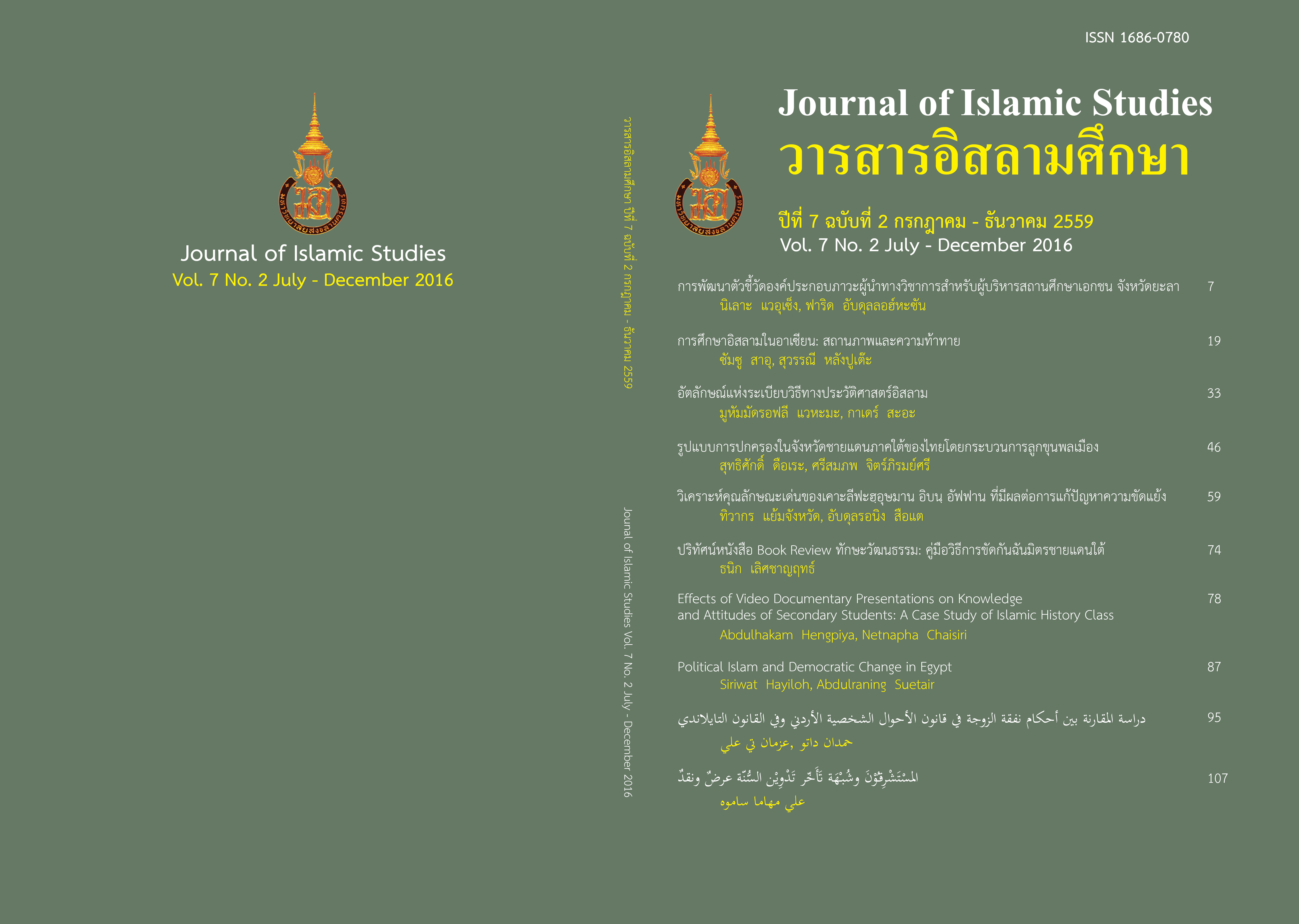Effects of Video Documentary Presentations on Knowledge and Attitude of Secondary Students: A Case Study of Islamic History Class
คำสำคัญ:
Video documentary presentations, knowledge, attitude, history of Prophet Muhammad Salla Llahu ʿAlay-hi Wa-sallamบทคัดย่อ
This study examined the effects of video documentary presentations on students’ knowledge and attitude in social study, religion and culture subject under the unit of Islamic history (al-Tarikh), titled “History of Prophet Muhammad Salla Llahu ʿAlay-hi Wa-sallam” of the first secondary grade students. The classroom action research was employed to enhance knowledge of the subject matter and positive attitude toward Islamic history class by applying video documentary media. One of the classes of Khuan Don Wittaya secondary school in Satun province, south of Thailand was purposively selected to be research participants consisting of 28 students. Students’ knowledge indicated by their learning achievement was assessed through a multiple choice test, while their attitude toward Islamic history class was examined by a questionnaire survey. The results of paired samples t-test showed that the score of pre-test (x̅ = 6.29 and S.D = 0.93) and post-test (x̅ = 8.32 and S.D = 0.94) were statistically significant different at 0.50. This implies that the students’ learning achievement in Islamic history class has improved significantly after using video documentary presentations. Students’ attitude was also reported to have favorable attitude toward Islamic history class (x̅ = 4.02 and S.D = 0.82).
เอกสารอ้างอิง
Atagi, R. (2011). Secondary teacher policy research in Asia: Secondary teachers in Thailand. Bangkok: UNESCO Bangkok. Retrieved February 10, 2017, from www.uis.unesco.org/.../secondary-teacher-policy-research-asia-thailand-education-20
Bacon, C. S. (1993). Student’s responsibilities for learning. Adolescence 29 (109), 199-211.
EDC’s Center for Children and Technology. (2004). Television goes to school: the impact of video on student learning in formal education. New York: Susan Saltrick Margaret Honey Shelley Pasnik.
Gardner, H. (2000). Can technology exploit our many ways of knowing?” In D.T. Gordon. (Ed.). The digital classroom: How technology is changing the way we teach and learn (pp. 32-35). Cambridge, MA: Harvard College.
Hoynes, W. (1994). Public television for sale: Media, the market and the public sphere. Boulder, CO: Westview Press.
Kazemi, F., Shahmohammadi, A. & Sharei, M. (2013). The survey on relationship between the attitude and academic achievement of in-service mathematics teachers in introductory probability and statistics. World Applied Sciences Journal 22 (7), 886-891
Ljubojevic, M., Vaskovic, V., Stankovic, S., & Vaskovic, J. (2014). Using supplementary video in multimedia instruction as a teaching tool to increase efficiency of learning and quality of experience. The international review of research in open and distributed learning, 15 (3). Retrieved February 10, 2017 from http://www.irrodl.org/index.php/irrodl/article/view/1825
Oosterhof, A. (1990). Classroom Applications of Educational Measurements. Merrill, Columbus, OH.
Perales-Palacios, F.J. and Vilchez-González, J.M. 2005. The teaching of physics and cartoons: Can they be interrelated in secondary education? International Journal of Science Education, 27 (14), 1647-1670.
Roach, V., & Lemasters, L. (2006). Satisfaction with online learning: a comparative descriptive study. Journal of Interactive Online Learning, 5 (3), 317-332.
Zuckerman, G. (1995). Effects of different modes of classroom video presentations on attitudes and knowledge of eighth-grade history students. (Doctoral dissertation). Fordham University.
ดาวน์โหลด
เผยแพร่แล้ว
รูปแบบการอ้างอิง
ฉบับ
ประเภทบทความ
สัญญาอนุญาต
บทความทุกเรื่อง ที่ได้รับการตีพิมพ์ในวารสารอิสลามศึกษาเป็นแนวคิดของผู้เขียน มิใช่เป็นความคิดเห็นคณะผู้จัดทำและมิใช่ความรับผิดชอบของคณะวิทยาการอิสลาม กองบรรณาธิการไม่สงวนสิทธิ์การคัดลอก แต่ให้มีการอ้างอิงแสดงที่มา




